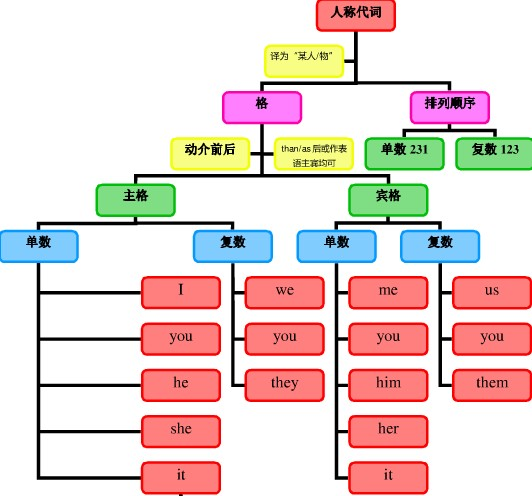本试题 “It was the young man ___ had been looking for ___ caught the murderer.[ ]A. that; whoB. that; theyC. they; thatD. they ; which” 主要考查您对人称代词
强调句
等考点的理解。关于这些考点您可以点击下面的选项卡查看详细档案。
- 人称代词
- 强调句
人称代词的概念:
人称代词是替代我、你、他、她、它、我们、你们、他们、她们、它们等人称的词。
人称代词分为主格和宾格形式,并有人称的单复数形式。按所替代人称的不同分为第一人称、第二人称和第三人称。
人称代词的用法:
人称代词在句中可以用作主语(用主格,如:I,you,he,she,we,they,等)和宾语(用宾格,如 me,you,him,her,us,them等)
如:He loves her, but she hates him. 他爱她,但她却讨厌他。
注:(1)在口语中,当人称代词用作表语、用于than, as之后或用于强调句中被强调时,可以用语。 例如:
"Who is it?" "It's me."“是谁呀?”“是我。”
He sings better than me. 他比我唱得好。
He is as tall as her. 他和她一样高。
It's me who did it. 这是我干的。但是,若than,as后的人称代词后跟有动词,则必须用主格。例如:
He sings better than I do./ He is as tall as she is.
(2)单独使用的人称代词通常用宾格。
"I' m tired.""Me too."“我累了。”“我也累了。”
"Who wants this?" "Me."“谁要这个?”“我要。”
(3)有时用主格或宾格会导致意思的变化。
I like you better than he. 我比他更喜欢你。为 I like you better than he likes you. 之略。
I like you better than him. 我喜欢你胜过喜欢他。为 I like you better than he likes him. 之略。
人称代词主格、宾格、人称、单复数对比:
|
人称代词 |
单数 |
复数 | ||
|
主格 |
宾格 |
主格 |
宾格 | |
|
第一人称 |
I |
me |
we |
us |
|
第二人称 |
you |
you |
you |
you |
|
第三人称 |
he |
him |
they |
them |
|
she |
her |
them | ||
|
it |
it | |||
人称代词的排序:
人称代词的排列顺序为:单数人称代词通常按“二三一”排列,即you, he and I;复数人称代词通常按“一二三”排列,即we, you and they:
You, he and I are of the same age. 你,他和我都是同一年龄。
We, you and they are all good citizens. 我们,你们和他们都是好公民。
但若是用于承担责任或错误等场合,则可把第一人称I置于其他人称代词之前:
I and Tom are to blame. 我和汤姆该受批评。
比较:Tom and I hope to go there. 汤姆和我想去那儿。
注意:you and I 是固定结构,语序通常不宜颠倒。
人称代词知识体系:

人称代词用法拓展:
1、在通常情况下,人称代词在句子中出现在它所代替的名词之后,即先出现名词,再出现相应的代词。但是,在书面语中,有时也可出现代词,后出现代词所代替的名词。
As soon as it had hopped off, the plane picked up speed.飞机刚一起飞,就加了速。
(比较:As soon as the plane had hopped off, it picked up speed.)
2、人称代词后跟名词同位语。有些人称代词后有时可跟同位语。
These small desks are forus students.这些小课桌是给我们学生的。
We girls often go to the movies together.我们女孩子常一起去看电影。
He asked you boys to be quiet.他要你们男孩子安静些。
强调句的概念:
强调句 (The Emphatic Pattern) 是一种修辞,是人们为了表达自己的意愿或情感而使用的一种形式。通过各种方式对句子中的某个部分进行强调,从而起到修辞的作用。英语常用的强调结构有:It is (was)+被强调部分(主语、宾语或状语)+that/who...;what…be…句型;
强调句的使用:
一、强调句句型:
1、用It is/was...that/who...句型表示强调。
(1)陈述句的强调句型:It is/was+被强调部分(通常是主语、宾语或状语)+that/who(当强调主语且主语指人)+其它部分。
e.g. It was yesterday that he met Li Ping.
(2)一般疑问句的强调句型:同上,只是把is/was提到it前面。
e.g. Was it yesterday that he met Li Ping?
(3)特殊疑问句的强调句型:被强调部分(通常是疑问代词或疑问副词)+is/was+it+that/who+其它部分?
e.g. When and where was it that you were born?
注:被强调的部分(通常是句子的主语、状语、宾语或宾语补足语)放在is/was的后面,如被强调的是人,则后面可用who,whom等代替。
如:原句:He met an old friend in the park yesterday.
强调主语:It was he who/that met an old friend in the park yesterday.
强调宾语:It was an old friend that/who he met in the park yesterday.
强调地点状语:It was in the park that he met an old friend yesterday.
强调时间状语:It was yesterday that he met an old friend in the park.
2、用助动词do, does或did来强调谓语动词。
如:Do come early.
He did send you a letter last week.
We're pleased that she does intend to come.
3、用主语从句+be+被强调部分,主语从句常用what引导。
如:What John wants is a ball.
What Mary does every day is(to) give piano lessons.
二、not...until...句型的强调句:
1、句型为:It is/was not until+被强调部分+that+其它部分:
e.g. 普通句:He didn't go to bed until/till his wife came back.
强调句:It was not until his wife came back that he went to bed.
2、注意:此句型只用until,不用till。但如果不是强调句型,till, until可通用;
因为句型中It is/was not...已经是否定句了,that后面的从句要用肯定句,切勿再用否定句了。
三、谓语动词的强调:
1、It is/was...that...结构不能强调谓语,如果需要强调谓语时,用助动词do/does或did。
e.g. Do sit down.务必请坐。
He did write to you last week. 上周他确实给你写了信。
Do be careful when you cross the street. 过马路时,务必(千万)要小心啊!
2、注意:此种强调只用do/does和did,没有别的形式;过去时用did,后面的谓语动词用原形。
使用强调句型有以下几点请注意:
①强调句的谓语is或was永远用单数。
如:It was yesterday that I met your father in the street.
②不管被强调部分是哪种状语,只能用that连接,不得使用where、when等连词。
如:It was in the street that I met your father yesterday.
③被强调部分为人时,可用who(主格或宾格)和whom(宾格)代替that,用that也行。
如:It was your father that/whom/who I met in the street yesterday.
It was I that/who met your father in the street yesterday.
④强调句中也要注意主谓一致、人称一致和否定转移的问题。
如:It is they who are our friends.
It was not until ten o'clock that we got home last night.
⑤注意不要混淆强调句和其他从句。It is/was...that...为强调句标志,去掉后仍可组成一个完整的句子,只是没被强调,而其他从句一般不具备这一特征。
比较:1)It was ten o'clock when we got home last night. 我们昨晚到家时已十点了。
2)It was at ten o'clock that we got home last night. 我们昨晚是在十点到家的。
第一句不是强调句,when不可改为that,因为去掉it was和that后,只能组成“We got home ten o'clock last night.”这样一个不完整的句子;第二句是强调句,that不可改为when。
强调句型用法拓展:
1、句首词用“It”,不能用“This”,“That”等。
2、be动词的形式是is或was,不能用复数形式are或were。若原句的谓语动词用了现在时或将来时,则用is;
若原句的谓语动词用了过去时或过去完成时,则用was。
如:It___the Chinese women that___a great role in the socialist construction.
A. is; plays
B. are; play
C .is; play
D. are; plays
答案:C
3、被强调的部分如果是代词,强调主语用主格,强调宾语用宾格。
如:It is him that/who/whom I met in the street yesterday.
It is I who/that am wrong.
4、连接词一般用that,当强调部分是人时,既可用that也可用who。特别注意当强调部分是时间状语或地点状语时,不能用when或where。
如:It was on Oct1st, 1949 that People's Republic of China was founded.
It was at the gate____he told me the news.
A. that
B. what
C. which
D. when
答案:A
5、主谓一致问题被强调的主语要和that后面的谓语动词在数上保持一致。
如:It is Mary who often _____(help) me with my English. (helps)
It is I that ____(be) against you. (am)
6、not...until结构的强调。
强调“not...until”引导的时间状语时,要用“it is/was not until...that...”结构,that后面的句子要用肯定式,且须用陈述句语序。
如:We did not get off the bus until it stopped. ?
It was not until it stopped that we got off the bus. (注意:强调该结构时not until不能分开)
与“It was the young man ___ had been looking for ___ caught ...”考查相似的试题有:
- There are over 100 night clubs in the city, but you don’t often see that is empty.A.oneB.the oneC.itD.that
- People in the west make_______a rule to buy Christmas presents for their friends.A. thatB.itC. thisD. as
- When you are done with the book,just give it to Lucy or Helen or ________.A.whoeverB.whereverC.whateverD.however
- The skirt is too large for me.Would you show me ___ one ?A.the othersB.anotherC.otherD.an other
- -Wow! You’ve got so many clothes.-But _____ of them are in fashion now .A.allB.bothC.neitherD.none
- .You may drop in or just give me a call. __________ will do.A.EitherB.EachC.NeitherD.All
- The manager decided to give the job to ________ who he believed had a strong sense of duty.A.anyoneB.eachC.no oneD...
- It was not until the scientist died________we appreciated the true significance of his discoveries.[ ]A.afterB.befo...
- It is partly ______ the summer day is longer that everything has a larger time to warm up.[ ]A. forB. thatC. the reas...
- .Why !I have nothing to confess。________you want me to say?A.What is it thatB.What it is thatC.How is it thatD...